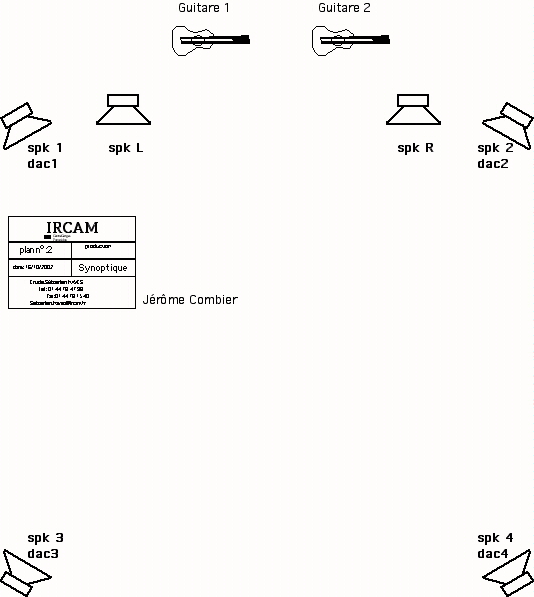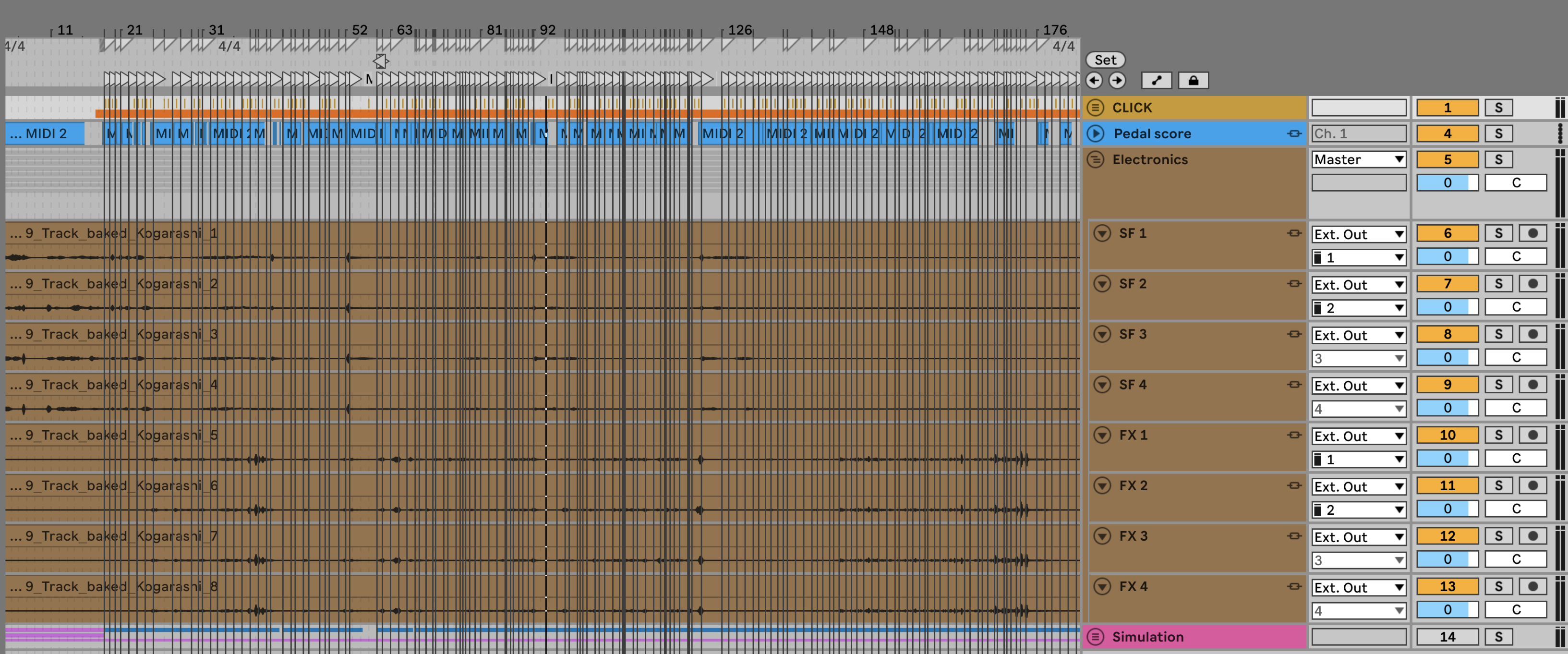Table of contents
Documentation date: 17 mai 2024
Version state
Valid
Validation date: 19 mai 2024
Version documentalist
- brecy (yann.brecy@ircam.fr)
Version realisation
- Yann Brecy (Computer Music Designer)
Version length
8 mn 15 sUpgrade Motivation
Tape version, all the electronics sound and realtime effects are prerecorded within an Ableton live session.
Other version(s)
- Jérôme Combier - Kogarashi, le premier soupir des fantômes - ACMM 2022
- Jérôme Combier - Kogarashi, le premier soupir des fantômes - mai-2012
- Jérôme Combier - Kogarashi, le premier soupir des fantômes - osx-2010
- Jérôme Combier - Kogarashi, le premier soupir des fantômes - transfert_mustica_ftp
- Jérôme Combier - Kogarashi, le premier soupir des fantômes - OS9-OSX Version
Detailed staff
- guitare
Channel details
- Number of output channel : 4
Electronic equipment list
Computer Music Equipment
-
1 Live - Music Software
(Ableton)
Version 11
Audio Equipment
-
2 KM140 - Dynamic Microphones
(Neumann)
or equivalent -
1 MKE 2-2R Red Dot - Lavalier Microphones
(Sennheiser)
or equivalent -
1 Schertler Harp - Contact Microphones
(Schertler)
or equivalent -
6 Loudspeaker - Loudspeakers
guitar amplification and electronics diffusion -
1 ear-monitor - Headphones
Work related information
Premiere
- 17 octobre 2002, France, Paris, Ircam
Publisher :
- Lemoine
Realisation
- Jean Lochard
Work length
- 8 mn
Useful links on Brahms
- Kogarashi, le premier soupir des fantômes pour guitare et électronique (2002), 8mn
- Jérôme Combier
| File | Author(s) | Comment | |
|---|---|---|---|
| Download [353,5 Mio] | Ableton session Kogarashi.zip | Yann Brecy | Ableton Live 11 session with baked electronics, click track and refenrence track |
Instructions
Description
In the realtime version of the piece, the guitarist triggers soundfiles and realtime effects throughout the piece.
This version is a “non-realtime” version, where all the electronics are prerecorded into a tape, within an Ableton live Session. A midi and an audio click track for synchronisation are provided to play alongside the tape.
Loudspeaker setup

Installation
- Download the main project.
- Open Kogarashi_offline.als with at least Ableton 11.x
audio Setup
No input beside the amplification of the two guitars
4 channel audio outputs for the tape
1 channel audio output for the click-track
- SR : 48KHz
Routing in Ableton
There are multipe tracks within the Ableton Live Session, to let some flexibilty regarding the mixing.
You will find :
4 mono tracks with the sound files :
- SF 1 : to speaker 1
- SF 2 : to speaker 2
- SF 3 : to speaker 3
- SF 4 : to speaker 4
4 mono tracks with the pre-recorded realtime effects :
- FX 1 : to speaker 1
- FX 2 : to speaker 2
- FX 3 : to speaker 3
- FX 4 : to speaker 4

You should route the midi or audio click tracks to an ear monitoring system for the instrumentalist.
The Reference tracks are only there for reference and synchro purposes. Must be muted during performance.
Performance Notes
The piece contains an introduction part with only sound files, and some fermatas during the rest of the piece. Since it’s a fixed version of the piece, you can have to modify the session.
The intro section does not have a click track. It must be played alongside the sound files. At the end of this introduction, the instrumentalist must change position and guitar.
The rest of the piece has a click track, and some clicks before after each fermata to know when to start again.
© IRCAM

This documentation is licensed under a Creative Commons Attribution-NonCommercial-NoDerivatives 4.0 International License.
Program note
« Le vent d’hiver dit Kogarashi (celui qui sèche les arbres) est la bise dont le souffle emporte les dernières feuilles. Exemple parfait d’une violence extrême, il n’a pourtant ni forme ni couleur, n’étant visible que par ce qu’il produit »1. Les fantômes sont ceux du Roi Lear (acte III) qui résonnent dans son esprit, fantômes inexpugnables errant sur la lande où Lear se perd absolument. Force surnaturelle, cette mythologie – croit-il – le soumet. D’eux ne parviennent que les soupirs portés par le vent. Un vent qui charrie le souffle de voix inconnues, ou bien s’agit-il de sa propre voix (« soufflée, ma voix revient vers moi » dit le poète Japonais 2). Un vent qui est l’espace devenu audible, mais un espace où le sol se dérobe, où tout se confond, bruits et sons, où ciel devient terre et terre devient ciel. Lear y meurt et y naît à la fois. « Le premier soupir des fantômes, c’est le dernier soupir des vivants » 3. * René Sieffert, Le Faucon impatient, Presses Orientalistes de France, Paris, 1994. * Meisetsu (1847-1926) dans L’Hôte, l’invité et le chrysanthème blanc, Haikus d’automne, éditions Moudarren, Millemont (France), 1990. * Jacques Dars, Aux portes de l’enfer, éditions Philippe Piquier, Arles, 1984.Jérôme Combier.
Version documentation creation date: 17 mai 2024 15:53, update date: 19 mai 2024 13:39